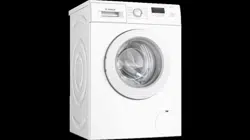Documents: Go to download!
User Manual
- User Manual - (English)
- Product Spec sheet - (English)
- Installation and connection
- Before using for the first time
- Laundry
- Cleaning and servicing
- Troubleshooting
Table of contents
User manual Washing Machine
Installation and connection
Unpacking the appliance
- Remove any packaging and protective covers completely from the appliance.
- Check the appliance for visible damage.
- ATTENTION! Objects remaining in the drum that are not designed for operation with the appliance may cause material damage and damage to the appliance.
▶ Remove these objects, along with all supplied accessories, from the drum before starting the appliance. Open the door and remove the accessory from the drum
Contents of package
After unpacking all parts, check for any damage in transit and completeness of the delivery.

 Washing machine
Washing machine
 Accompanying documents
Accompanying documents
 Water inlet hose
Water inlet hose
 Cover caps
Cover caps
Removing the transit bolts
The appliance is secured for transportation using transit bolts on the rear of the appliance.
Notes
- Please read the information in the “Safety” and "Preventing material damage" → sections to ensure that you use the appliance safely.
- Keep the transit bolts, screws and sleeves in a safe place for future "transport"
1. Pull the hoses out of the holders.
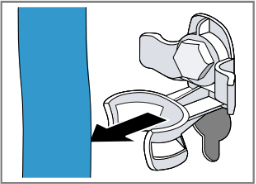
2. Unscrew (1) and remove (2) all four screws for the transit bolts with a WAF 13 wrench.
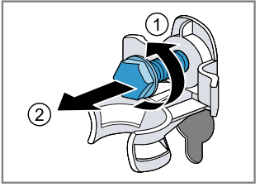
3. Pull the power cord out of the holder.
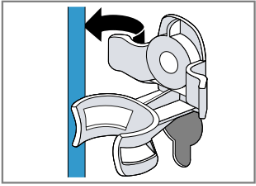
4. Remove the four sleeves.

5. Put on the four cover caps.
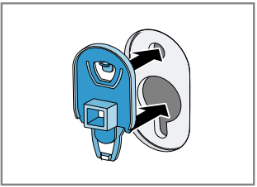
6. Press down on the four cover caps.

Connecting the appliance
Connect your appliance to the power supply, water inlet and water outlet.
Connecting the water inlet hose
Note
Please read the information in the "Safety" and "Preventing material damage" sections to ensure that you use the appliance safely.
1. Connect the water inlet hose.
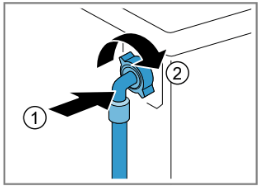
2. Connect the water inlet hose to a tap (26.4 mm = 3/4").

3. Open the water tap carefully and check that the connection points are tight.
Water outlet connection types
This information is intended to help you to connect this appliance to the water outlet.
Note: Please read the information in the Safety and Preventing material damage sections to ensure that you use the appliance safely.
ATTENTION!
When draining, the water outlet hose is subject to water pressure and may come loose from the installed connection point.
▶ Secure the water outlet hose against unintentional loosening.
Drainage into a siphon. Secure the connection point with a (24– 40 mm) hose clamp.

Drainage into a wash basin. Fix and secure the water outlet hose with an elbow
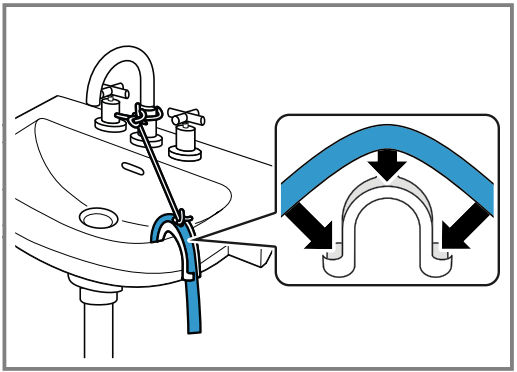
Drainage into a plastic pipe with rubber sleeve. Fix and secure the water outlet hose with an elbow

Connecting the appliance to the electricity supply
Note: Please read the information in the Safety and Preventing material damage sections to ensure that you use the appliance safely.
- Insert the mains plug of the appliance's power cable in a socket nearby. The connection details of the appliance can be found under Technical data.
- Check the mains plug is inserted properly.
Aligning the appliance
In order to reduce noise and vibration and to prevent the appliance from moving, align the appliance correctly.
Note: Please read the information in the "Safety" and “Prevent- ing material damage” sections to ensure that you use the appliance safely.
1. Loosen the lock nuts using a WAF17 wrench by turning it in a clockwise direction.

2. To align the appliance, turn the appliance feet. Check that the appliance is level using a spirit level.

All appliance feet must stand firmly on the ground.
3. Screw the lock nuts tightly against the housing using a WAF 17 wrench.
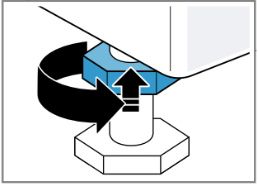
In doing so, hold the foot tight and do not adjust its height.
Before using for the first time
Prepare the appliance for use.
Starting an empty washing cycle
Your appliance was inspected thoroughly before leaving the factory. To remove any residual water, run the first wash cycle without any laundry.
Note: Please read the information in the "Safety" and "Prevent- ing material damage" sections to ensure that you use the appliance safely.
1. Turn the programme selector to Cottons 90° .
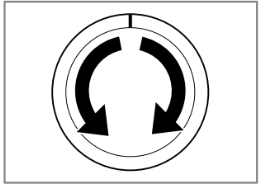
2. Close the door.
3. Pull out the detergent drawer.

4. Pour approx. 1 litre of tap water into compartment II.
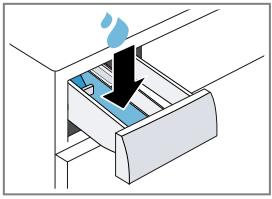
5. Pour washing powder into compartment II.
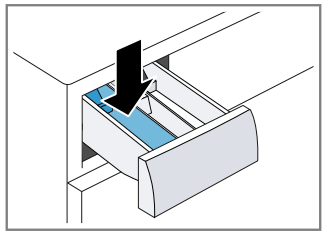
To prevent foaming, use only half of the amount of detergent recommended by the detergent manufacturer for light soiling. Do not use detergent suitable for woollens or delicates.
6. Push in the detergent drawer.

7. Press Start / Reload to start the programme.
- The display shows the remaining programme duration.
- After the programme has ended, the display shows: "End" .
8. Start the first wash cycle or set the programme selector to Off to switch off the appliance. → “Basic operation”
Laundry
You can wash all items that the manufacturer has marked as machinewashable on the care label and fabrics made from hand-washable wool using your appliance.
Preparing the laundry
Objects remaining in the laundry may damage the laundry and the drum.
▶ Remove all items from any pockets in your laundry before using the appliance.
▶ To protect your appliance and the laundry, prepare the laundry beforehand.
- Empty all pockets
- Brush sand out of all collars and pockets
- Close bed covers and cushion covers
- Close all zips, Velcro fasteners, hooks and eyes
- Tie cloth belts and apron strings together or use a mesh laundry bag
- Remove curtain hooks and lead strips or use a mesh laundry bag
- Use a mesh laundry bag for small items of laundry such as children's socks
- Separate items of laundry and shake them out
- Wash large and small items of laundry together
- Dab fresh stains with soapy water (do not rub them)
- Some stubborn or dried-in stains can be removed by washing several times
Sorting laundry
Note: Please read the information in the Safety and Preventing material damage sections to ensure that you use the appliance safely.
▶ To improve washing results and prevent discolouration, sort the laundry according to the following criteria before washing.
- Type of fabric and fibre type
- Whites
- Colours
- Wash new coloured items separately the first time you wash them.
- Soiling
- Care symbols on the care labels
Degrees of soiling
Degree of soiling | Soiling | Examples |
Light |
| Light summer clothing or sports clothing that has been worn for a just a few hours |
Normal | Dirt or light stains are visible |
|
Heavy | Dirt or stains are clearly visible | Tea towels, baby items or work clothing |
Care symbols on the care labels
The symbols indicate the recommended programme and the numbers in the symbols indicate the maximum recommended washing temperature.

Tip: You can find more information about care symbols at www.ginetex.
Detergents and care products
You can protect your appliance and your laundry by selecting and using the correct detergents and care products. You can use all detergents and care products which are suitable for domestic washing machines.
Note: Please read the information in the "Safety" and "Prevent- ing material damage" sections to ensure that you use the appliance safely.
The manufacturer's instructions for use and dosage can be found on the packaging.
Notes
- Only use liquid detergents that are self-flowing
- Do not mix different liquid detergents
- Do not mix detergent and fabric softener
- Do not use products that have expired or are highly congealed.
- Do not use products containing solvents, caustic agents or volatile substances (e.g. bleach)
- Use dyes sparingly as salt may damage stainless steel
- Do not use bleaching agents in the appliance
Detergent recommendation
This information helps you to choose the right detergent for your fabrics.
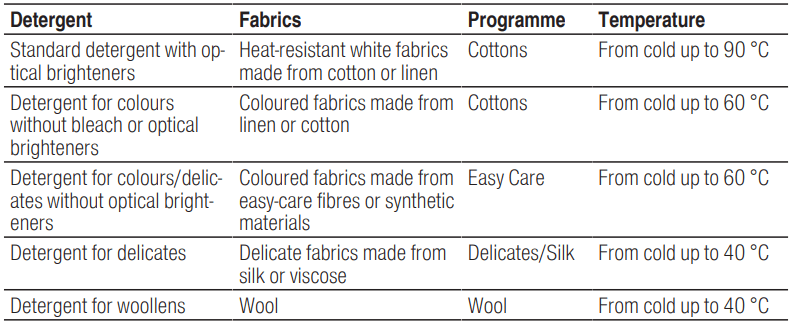
Tip: Visit cleanright.eu to find further information on detergents, care products and cleaning agents for domestic use.
Basic operation
You can find out everything you need to know about operating your appliance here.
Switching on the appliance
- Turn the programme selector to a programme.
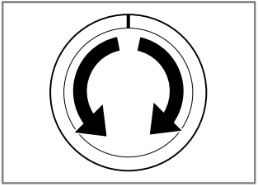
Setting a programme
1. Set the programme selector to the required programme
2. If necessary, adjust the programme settings

Adjusting the programme settings
Depending on the programme and programme progress, you can adjust or activate/deactivate the settings.
Note: Overview of all programme settings: → “Buttons”
Requirement: A programme has been set.
▶ Adjust the programme settings. The programme settings are not saved permanently for the programme.
Loading laundry
Notes
- Please read the information in the Safety and Preventing material damage sections to ensure that you use the appliance safely.
- To prevent creasing, take note of the maximum load for the relevant programme .
Requirement: Prepare and sort the laundry. → "Laundry"
1. Open the door.
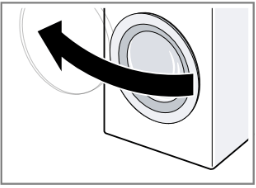
2. Ensure that the drum is empty.
3. Separate the laundry and place it in the drum.
4. Note: Ensure that there is no laundry trapped in the door.
Close the door.
Using a measuring aid for li- quid detergent
If you order the measuring aid as an accessory, you must use the measur- ing aid.
1. Pull out the detergent drawer.

2. Insert the measuring aid.
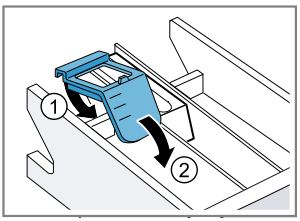
3. Insert the detergent drawer.
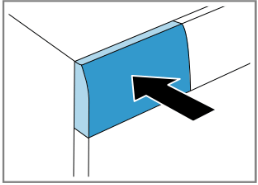
Adding detergent and care product
Notes
- Please read the information in the "Safety" and "Preventing material damage" sections to ensure that you use the appliance safely.
- Do not use the measuring aid for liquid detergent for gel detergents, washing powder, or if Prewash or "Ready in" time are activated.
Requirement: Find out the optimum dosage for detergent and care product."
- Pull out the detergent drawer.
- Pour in detergent. → “Detergent drawer”
- If required, add the care product.
- Push in the detergent drawer.
Starting the programme
Note: If you want to change the time until the programme ends, set the "Ready in" time first.
Press Start/Reload.
- The drum rotates and load detection takes place. This can take up to 2 minutes, after which water enters the drum.
- The display shows either the programme duration or the "Ready in" time.
- After the programme has ended, the display shows: End.
Soaking laundry
You can soak the laundry before washing in the appliance by pausing the programme.
Note: No additional detergent is required. The washing solution is then used for washing.
1. Start the programme.
2. To pause the programme, after approx. 10 minutes, press Start / Reload.
3. To resume the programme, after the desired soaking time, press Start / Reload.
Adding laundry
Note: Please read the information in the "Safety" and "Prevent- ing material damage" sections to ensure that you use the appliance safely.
- Press Start/Reload. The appliance is paused and checks whether it is possible to add or remove laundry. Take note of the programme status.→ "Display"
- Add or remove laundry.
- Close the door.
- Press Start/Reload.
Cancelling the programme
Once the programme has started, you can cancel it at any time.
Note: Please read the information in the "Safety" and "Prevent- ing material damage" sections to ensure that you use the appliance safely.
1. Press Start/Reload.
2. Open the door.
The appliance door remains locked for safety reasons if the temperature and water levels are high.
- If the temperature is high, start the Rinse programme.
- If the water level is high: Start the Spin or Drain programme.
3. Remove the laundry.
Resuming the programme when the programme status is Rinse Hold
- Set the Spin or Drain programme.
- Press Start/Reload.
Unloading the laundry
Note: Please read the information in the "Safety" and "Prevent- ing material damage" sections to ensure that you use the appliance safely.
- Open the door.
- Remove the laundry.
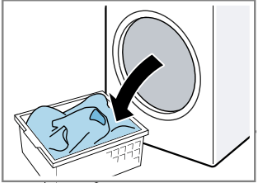
Switching off the appliance
1. Turn the programme selector to Off.
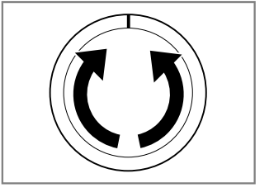
2. Turn off the tap.
3. Wipe the rubber gasket dry and re- move any foreign objects.
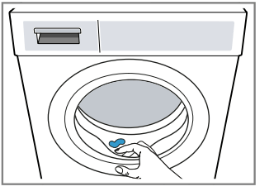
4. Leave the door and detergent drawer open so that residual water can evaporate.
Changing the basic settings

- Set the programme selector to po- sition 1.
- Press Spin Speed and, at the same time, turn the programme selector to position 2. The display shows the current value.
- Set the programme selector to the required position.
- To change the value, press Finish in.
- To save the changes, switch off the appliance.
Cleaning and servicing
To keep your appliance working effi- ciently for a long time, it is important to clean and maintain it carefully.
Tips on appliance care
Follow the tips for appliance care to ensure your appliance works cor- rectly in the long term.
- Wipe down the hous- ing and the control panel with nothing but water and a damp cloth.
- The appliance parts remain clean and hy- gienic.
- Remove all detergent residue, spray residue or other residues im- mediately.
- Fresh deposits are easier to remove without leaving any residue.
- Keep the appliance door and detergent drawer open after use.
- This allows the resid- ual water to dry, redu- cing odours in the ap- pliance.
Cleaning the drum
If you often wash at a washing tem- perature of 40 °C and lower or the appliance has not been used for a long period, clean the drum.
▶ Run the Cottons 90° programme without laundry.
Add washing powder.
Cleaning the detergent drawer
Note: Please read the information in the "Safety" and "Prevent- ing material damage" sections to ensure that you use the appliance safely.
1. Pull out the detergent drawer.
2. Press down on the insert and re- move the detergent drawer.
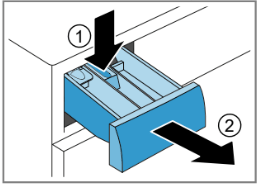
3. Press out the insert upwards from below.
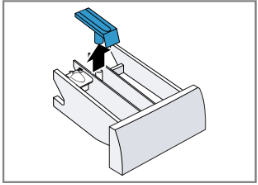
4. Clean the detergent drawer and in- sert with water and a brush, and then dry them.
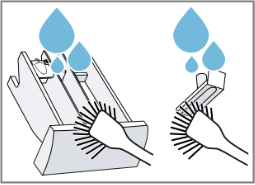
5. Fit the insert and lock it into place.
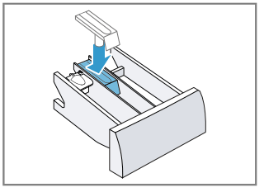
6. Cleaning the opening for the deter- gent drawer.
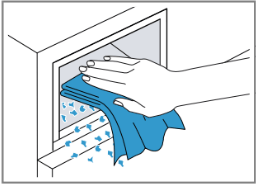
7. Push in the detergent drawer.
Descaling
If you add detergent correctly, you do not need to descale your appliance. If you still wish to use descaler, follow the manufacturer's instructions for use.
ATTENTION!
The use of unsuitable descaling agents, e.g. for coffee machines, may damage the appliance.
▶ For this appliance, only use descaling agents that are available from the manufacturer's website or our after-sales service.
Cleaning the drain pump
Clean the drain pump in the event of faults, e.g. blockages or rattling noises.
Emptying the drain pump
Note: Please read the information in the "Safety" and "Prevent- ing material damage" sections to ensure that you use the appliance safely.
1. Turn off the water tap.
2. Switch off the appliance.
3. Disconnect the appliance's mains plug from the power supply.
4. Open the maintenance flap.
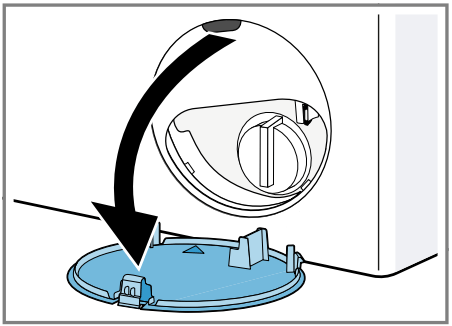
5. Push a receptacle under the opening.
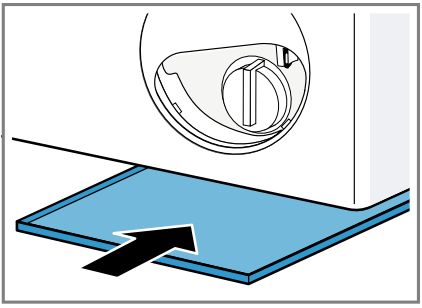
6. To allow the detergent solution to flow out into the container, remove the pump cap carefully
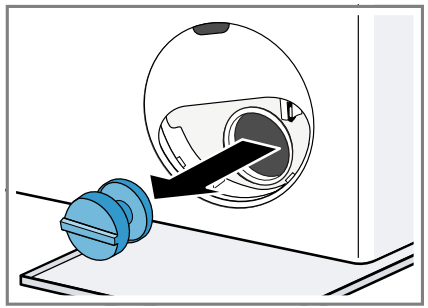
Cleaning the drain pump
Note: Please read the information in the "Safety" and "Prevent- ing material damage" sections to ensure that you use the appliance safely.
Requirement: “The drain pump is empty.”
1. Because water may remain in the drain pump, remove the pump cap carefully.
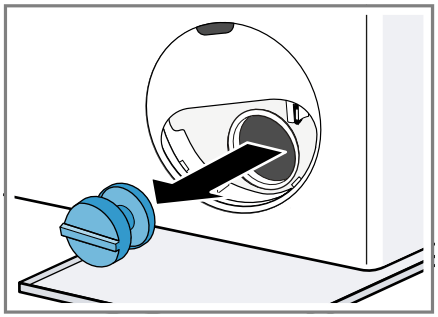
2. Clean the interior, the thread on the pump cap and the pump housing.
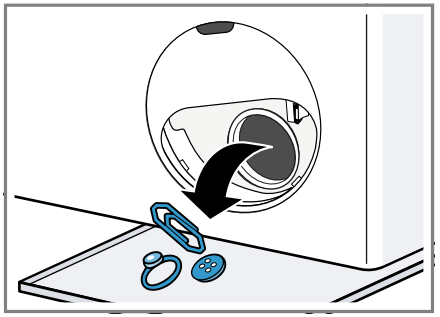
3. Make sure that the impeller in the drain pump can be turned.
4. Insert the pump cap and screw it on.

The handle on the pump cap must be in a vertical position.
5. Insert the maintenance flap and lock it into place.
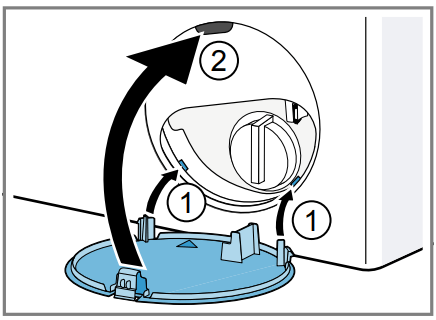
6. Close the maintenance flap.
Before the next wash
To prevent unused detergent from flowing straight into the outlet in the next wash, run the Drain programme after you have emptied the drain pump.
- Turn on the tap.
- Insert the mains plug.
- Switch on the appliance.
- Pour 1 litre of water into compartment II.
- Start the Drain programme.
Cleaning the water outlet hose at the siphon
If the water outlet hose at the siphon is dirty or the detergent solution is not being pumped out, you must clean these.
1. Switch off the appliance.
2. Disconnect the appliance's mains plug from the power supply.
3. Loosen the hose clamp and care- fully remove the water outlet hose.

Residual water may leak out.
4. Clean the water outlet hose and si- phon connecting piece.

5. Reattach the water outlet hose and secure the connection point using the hose clamp.
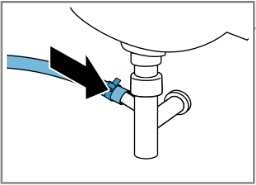
Clean the water inlet filters.
Clean the filter in the water inlet in the event of blockages or if the water pressure is too low.
Emptying the water inlet hose
- Turn off the tap.
- Set a programme, except for Rinse, Spin or Drain.
- Start the programme and leave it to run for approx. 40 seconds.
- Switch off the appliance.
- Disconnect the appliance's mains plug from the power supply.
Cleaning the filter on the tap
Note: Please read the information in the "Safety" and "Prevent- ing material damage" sections to ensure that you use the appliance safely.
Requirement: The water inlet hose is empty.
1. Remove the water inlet hose from the tap.
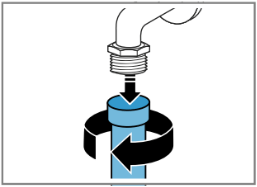
2. Clean the filter with a small brush.

3. Connect the water inlet hose and check for leaks.
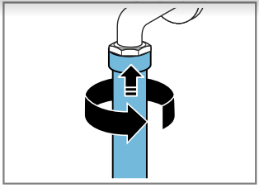
Cleaning the filter on the appliance
Note: Please read the information in the "Safety" and "Prevent- ing material damage" sections to ensure that you use the appliance safely.
Requirement: The water inlet hose is empty. → "Emptying the water inlet hose", Page 45
1. Disconnect the hose from the rear of the appliance.
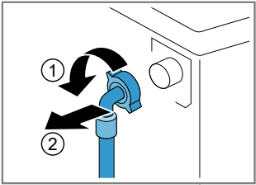
2. Use pliers to remove the filter.
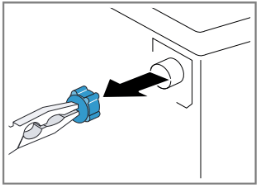
3. Clean the filter with a small brush.
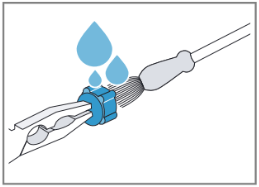
4. Reinsert the filter.
5. Connect the hose and check for leaks.
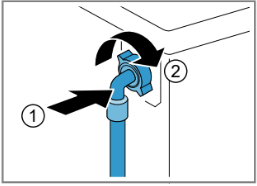
Troubleshooting
You can rectify minor faults on your appliance yourself. Read the troubleshoot- ing information before contacting after-sales service. This will avoid unneces- sary costs.
WARNING
Risk of electric shock!
Improper repairs are dangerous.
▶ Repairs to the appliance should only be carried out by trained specialist staff.
▶ Only use genuine spare parts when repairing the appliance.
▶ If the power cord of this appliance is damaged, it must be replaced by the manufacturer, the manufacturer's Customer Service or a similarly qualified person in order to prevent any risk.
Error code / Fault display / Signal
Fault | Cause | Troubleshooting | |
The display goes out and Start / Reload flashes. | Energy-saving mode is active | ▶ Press any button. a The symbol lights up again. | |
"E:36 / -10" | Drain pipe or water outlet hose is blocked. | ▶ | Clean the drain pipe and the water outlet hose. |
Drain pipe or water drain hose is caught or jammed. | ▶ | Ensure that the drain pipe and water drain hose are not kinked or trapped. | |
Drain pump is blocked. | ▶ | → "Cleaning the drain pump", Page 38 | |
The water outlet hose is connected too high. | ▶ | Install the water outlet hose at a maximum height of 1 metre. → "Technical specifications", Page 54 | |
"E:36 / -25 / -26" | Drain pump is blocked. | ▶ | → "Cleaning the drain pump", Page 38 |
"E:60 / -2B" | The unbalanced load detection system has interrupted the spin cycle because the laundry is unevenly distributed. | ▶ Redistribute the laundry in the drum. Note: Where possible, mix large and small items in the drum. Different sized items of laundry distribute themselves better during the spin cycle. | |
| The water pressure is low | No remedial action possible. | |
| The filters in the water inflow are blocked. | Clean the filters in the water inflow | |
 | The tap is turned off. | Turn on the tap. | |
| The water inlet hose is kinked or jammed | Ensure that the water inlet hose is not kinked or jammed. | ||
 lights up. lights up. | The temperature is too high. | Wait until the temperature has dropped. → "Cancelling the programme" | |
| Water level is too high. | Start the Drain programme. | ||
| Laundry is caught in the doo | 1. Open the door again. 2. Remove any trapped laundry. 3. Close the door. 4. Press Start / Reload to start the programme | ||
 flashes. flashes. | Door is not closed. | 1. Close the door. 2. Press Start / Reload to start the programme. | |
| All other error codes. | Malfunction | Call the after-sales service. → "Customer Service" | |
Malfunctions
Fault | Cause | Troubleshooting | |
The appliance is not working. | The mains plug of the power cord is not plugged in. | ▶ | Connect the appliance to the power supply. |
The circuit breaker is faulty. | ▶ | Check the circuit breaker in the fuse box. | |
There has been a power cut. | ▶ | Check whether the lighting in your kitchen or other appliances are working. | |
The programme does not start. | You have not pressed Start / Reload. | ▶ | Press Start / Reload. |
Door is not closed. | 1. | Close the door. | |
|
| 2. | Press Start / Reload to start the programme. |
Childproof lock is activated. | ▶ | → "Deactivating the childproof lock", Page 35 | |
Finish in is activated. | ▶ | Check whether Finish in is activated. → "Buttons", Page 23 | |
Fault | Cause | Troubleshooting | |
The programme does not start. | Laundry is caught in the door. | 1. 2. | Open the door again. Remove any trapped laundry. |
|
| 3. | Close the door. |
|
| 4. | Press Start / Reload to start the programme. |
The door cannot be opened. | – –– is activated. | ▶ | Continue the programme by selecting Spin or Drain and pressing Start / Reload. → "Resuming the programme when the programme status is Rinse Hold", Page 34 |
The temperature is too high. | ▶ | Wait until the temperature has dropped. | |
|
| ▶ | → "Cancelling the programme", Page 34 |
Water level is too high. | ▶ | Start the Drain programme. | |
Power failure. | ▶ | Open the door using the emergency release. → "Emergency release", Page 50 | |
The water is not draining. | Drain pipe or water outlet hose is blocked. | ▶ | Clean the drain pipe and the water outlet hose. |
Drain pipe or water drain hose is caught or jammed. | ▶ | Ensure that the drain pipe and water drain hose are not kinked or trapped. | |
Drain pump is blocked. | ▶ | → "Cleaning the drain pump", Page 38 | |
– –– is activated. | ▶ | Continue the programme by selecting Spin or Drain and pressing Start / Reload. → "Resuming the programme when the programme status is Rinse Hold", Page 34 | |
The water outlet hose is connected too high. | ▶ | Install the water outlet hose at a maximum height of 1 metre. → "Technical specifications", Page 54 | |
Water is not flowing in. Detergent is not being dispensed. | You have not pressed Start / Reload. | ▶ | Press Start / Reload. |
The filters in the water inflow are blocked. | ▶ | Clean the filters in the water inflow → Page 41. | |
Fault | Cause | troubleshooting | |
Water is not flowing in. Detergent is not being dispensed. | The tap is turned off. | ▶ Turn on the tap. | |
The water inlet hose is kinked or jammed. | ▶ Ensure that the water inlet hose is not kinked or jammed. | ||
The spin cycle runs several times. | The unbalanced load detection system eliminates an imbalance by repeatedly redistributing the laundry. | ▶ Not a fault – no action required. Note: When loading, where possible, place large and small items of laundry together in the drum. Different sized items of laundry distribute themselves better during the spin cycle. | |
The programme duration changes during the wash cycle. | The programme operation is optimised electronically. This may change the programme duration. | ▶ Not a fault – no action required. | |
The unbalanced load detection system eliminates an imbalance by repeatedly redistributing the laundry. | ▶ Not a fault – no action required. Note: When loading, where possible, place large and small items of laundry together in the drum. Different sized items of laundry distribute themselves better during the spin cycle. | ||
Foam detection system switches on a rinse cycle if foam build-up is too high. | ▶ Not a fault – no action required. | ||
No water is visible in the drum. | Water is below the visible area. | ▶ Not a fault – no action required. | |
Drum jerks after the programme starts. | This is caused by an internal motor test. | ▶ Not a fault – no action required. | |
Residual water is present in the compartment  | Insert in compartment  is blocked. is blocked. | → “Cleaning the detergent drawer” | |
Fault | Cause | Troubleshooting | |
| Vibrations and movement of the appliance whilst spinning. | Appliance is not correctly aligned. | ▶ Aligning the appliance | |
| The appliance feet are not fixed. | ▶ Secure the appliance feet. Aligning the appliance | ||
| Transit bolts have not been removed. | ▶ Removing the transit bolts | ||
| Drum does not turn, water does not flow in. | Load detection is active. | ▶ Not a fault – no action required. Note: The load detection can take up to two minutes. | |
Heavy foam build-up | Detergent dosage is too high. | ▶ Immediate measure: Mix one tablespoon of fabric softener with 0.5 litres of water and pour the mixture into the left-hand compartment (not for outdoor clothing, sportswear or items stuffed with down). ▶ Reduce the amount of detergent for the next washing cycle with the same load. | |
Noise |
|
| |
Fault | Cause | Troubleshooting | |
Rushing, hissing noise. | Water is flushed under pressure into the detergent drawer. | ▶ | Not a fault – normal operating noise. |
Loud noises during the spin cycle. | Appliance is not correctly aligned. | ▶ | Aligning the appliance |
The appliance feet are not fixed. | ▶ | Secure the appliance feet. Aligning the appliance | |
Transit bolts have not been removed. | ▶ | Removing the transit bolts | |
Banging noises, rattling in the drain pump. | Foreign bodies have got into the drain pump. | ▶ | → "Cleaning the drain pump", Page 38 |
Slurping, rhythmical suction noise. | The drain pump is active, the detergent solution is pumped out. | ▶ | Not a fault – normal operating noise. |
Problem with results |
|
| |
Fault | Cause | Troubleshooting | |
Creasing | The spin speed is too high. | ▶ | The next time you run a wash cycle, set a lower spin speed. |
| The load is too large. | ▶ | The next time you run a wash cycle, reduce the amount of laundry being loaded. | |
| . | The wrong programme is selected for the type of fabric | ▶ | Select the programmes that are suitable for the type of fabric. → "Programmes", Page 24 |
Fault | Cause | Troubleshooting | |
Detergent or fabric softener drips off the seal and collects on the door or in the seal fold. | Too much detergent/fabric softener in the detergent drawer. | ▶ | When dosing liquid detergent and fabric softener, observe the marking in the detergent drawer and do not dose above this. |
The spin result is not satisfactory. The laundry is too wet/too damp. | A low spin speed is selected. | ▶ ▶ | The next time you run a wash cycle, set a higher spin speed. Start the Spin programme. |
The unbalanced load detection system has interrupted the spin cycle because the laundry is unevenly distributed. | ▶ No sm ite be ▶ | Redistribute the laundry in the drum. te: Where possible, mix large and all items in the drum. Different sized ms of laundry distribute themselves tter during the spin cycle. Start the Spin programme. | |
Detergent residue on the damp washing. | Detergents may contain water-insoluble substances that deposit on the laundry. | ▶ | Start the Rinse programme. |
Detergent residue on the dry laundry. | Detergents may contain water-insoluble substances that deposit on the laundry. | ▶ | Brush out the laundry after washing and drying. |
Leakage |
|
|
|
Fault | Cause | Troubleshooting | |
Water is leaking out at the water inlet hose. | Water inlet hose is not correctly/securely connected. | 1. | Connect the water supply hose correctly. Connecting the water inlet hose |
|
| 2. | Tighten the screw connection. |
Water is leaking out at the water outlet hose. | The water outlet hose is damaged. | ▶ | Replace the damaged water outlet hose. |
Water outlet hose is not connected correctly. | ▶ | Connect the water outlet hose correctly. Water outlet connection types | |
Odours
Fault | Cause | Troubleshooting |
Odours have formed in the appliance. | Humidity and detergent residue may promote the formation of bacteria. | ▶ → "Cleaning the drum", Page 37 ▶ If you are not using the appliance, leave the door and detergent drawer open so that residual water can evaporate. |
See other models: WAN24109GB WAN28281GB WAN282X1GB WAU24T64GB WAU28S80GB

